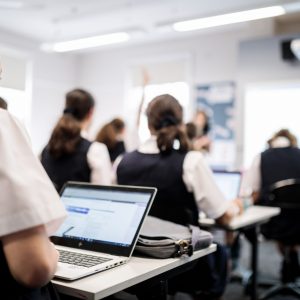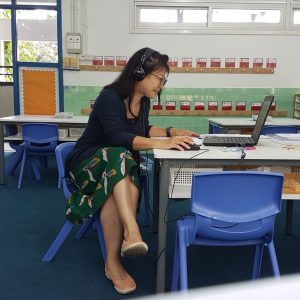
In This Together
Long-term school closures: What can teachers and parents learn from our friends in Hong Kong about learning from home?
In the last fortnight, there has been a great deal of discussion in the community about the coronavirus and what strategies we might use as a country to help look after all Australians. This has included suggestions such as mandatory long-term school shutdowns which have already been enacted in other countries around the world, both this year and on previous occasions for outbreaks of other viruses. As we continue to think ahead about a whole range of different scenarios, Carol Saunders, our Head of Academic Support, shares experiences and reflections from parents and colleagues working in Hong Kong where schools are in the middle of a 3-month school closure.
I am so proud of my three kids and their cousin who managed to do home learning for 5 hours solidly today- amazing lessons set by teachers who are running virtual online classrooms and meetings. All the kids are getting lots of support. (Parent in Hong Kong)

I taught in Hong Kong for 13 years including during the SARS outbreak of 2003. As we all follow the worldwide impact of COVID-19, I’ve been fascinated to see how my colleagues, dealing with school closures, are reacting to this challenge. I spoke to teachers, parents and school psychologists to understand what education is like in this changed world of the coronavirus.
In Hong Kong schools closed at the end of January for the Chinese Lunar New Year and are not due to open until the end of the Easter holiday on 20 April.
From Kindergarten through to Year 12 classes are continuing. This has been a massive undertaking for all stakeholders: teachers challenged to prepare lessons suitable for online delivery, students working from home without the support of their classmates and parents with disrupted work lives finding unconventional ways to support their children.
Technology
One of the biggest differences between teaching at the time of SARS and now is the proliferation of technology and the array of tools available today. All the teachers I spoke with talked about the steep technological learning curve for both themselves and their students. As the realisation that schools weren’t going to open any time soon set in, teachers shifted from setting independent work for students to complete during lesson times to using online platforms and conferencing technology to create virtual classrooms.
Teachers continue to deliver lessons in real time and students have their regular timetables, but in a very short time, everyone has had to become a proficient user of Zoom, Google hangouts, Padlet etc in order to adapt to their new classrooms.
A teacher writes, “I am setting all lesson content on Google classroom and Edpuzzle complemented by a live Zoom lesson so we can all chat face to face as a class. My lessons are now taken all over the word in multiple time zones as some students who have left Hong Kong log on from Canada, Australia, Japan, and the UK all in one online class.”
Teachers have had to be become more inventive and creative. Teaching from home without access to the many physical resources of a school environment is challenging. I’ve heard stories from a drama teacher using vegetables as props for teaching mime and a PE teacher videoing herself doing exercises on the living room carpet.
The Importance of Relationships and Human Contact

Every teacher I spoke to emphasised the importance of relationships and how they were missing daily contact with colleagues and students. Students too are actively seeking connection with their peers and teachers. A teacher described how students were choosing to stay online and requesting that she stay online even in their study periods, so that they could see each other and gain reassurance. She said this was more about emotional support than academic support and that students reported a sense of loss once cameras were turned off. Online lesson attendance is high with similar or higher numbers of students present than on “normal” school days. A school psychologist comments, “Although there is a belief that our young people are most at home in the online world, that they ‘feel so connected’ in the virtual world, many students are realising what being at school, in the classroom with teachers and with peers, what hanging out with friends brings them. We have heard from so many students, even from some for whom being in school is difficult, commenting, ‘I never thought I’d say this, but I really miss coming to school’.”
Working in isolation takes its toll and some teachers are choosing to work from school rather than at home, “Seeing people, even if behind masks and across a few metres of corridor for the most apprehensive, became a joyful reunion.”
Physical and Emotional Wellbeing
School calendars and timetables run on predetermined, predictable patterns. The health uncertainties of COVID-19 and the extended delay in returning to school has eroded both teachers’ and students’ sense of personal agency.
In addition to considering the purely academic outcomes of school closure, educators are focusing on the mental and emotional wellbeing of their communities and how to put well-being initiatives in place. Schools are encouraging more play, less work(sheets) for their students and for their teachers
A key challenge is that family homes have become places of quarantine, work and learning. Colleagues talked about the stress of not having the physical separation of home and work and how finding the physical and mental space to relax was a crucial factor in maintaining emotional health and resilience.
Parenting
Home schooling has challenged parents, especially parents of younger children, to manage their own work and childcare commitments. Parents are more actively involved in their children’s education often finding unique ways to foster and support creativity at home. A friend writes, “My son has built a hovercraft, a crossbow and a winged glider so being at home has been a big plus for him.”
The parents I talked to were effusive in their praise of the quality of work being given to students:
“I am so impressed with the quality of online learning offered, especially to my primary age twins who are becoming way more independent- they are still experiencing a full curriculum, with literacy and numeracy, units of enquiry and even Art, Music, PE, Library and Chinese lessons in the mix.”
Conquering the Challenge of Change
Teaching in the time of the COVID-19 poses enormous challenges. Hong Kong schools have had to adapt and find flexible, creative solutions. They have embraced this extraordinary situation as an opportunity to promote personal and professional growth. Teachers, students and parents alike have been pushed out of their comfort zones but have found new spaces to confront and conquer the challenge of change.
I would like to thank my friends in Hong Kong – teachers, parents and school psychologists who contributed their reflections. My personal and professional admiration goes out to you all.
Carol Saunders
Head of Academic Support


